



Top row: Rock carvings in Val Camonica, Italy: rock 50, rock 1 - warriors on horses, rock 35 - running priest, rock 50 - warrior.
Bottom row: View over Capo di Ponte toward Concarena peak. Entrance of the Naquane Park.
Today, we stopped in just one of many parks in the region and spent a few hours. We are at Capo di Ponte, in the Province of Brescia, Italy. Specifically, we are just on the edge of the village and uphill in the Parco nazionale delle incisioni rupestri di Naquane.
This park was created in 1955 by the Archaeological Superintendence of Lombardy, extends over 35 hectares on hills east of the Oglio river, ranging in altitude from 400 to 600 meters above sea-level. There are many paths within the park that allow you to get up close to the engravings.
Some resources to help:
About Val Camonica:
This rock has more than two thousand figures engraved over its surface; it is not easy to see them all, even less to remember them. The most ancient figures, very few, date back to the recent phases of the Neolithic, six thousand years ago. The great majority of the others were engraved during the end of the Bronze Age and above all (over 80%) throughout the Iron Age, during the 1st millennium BC.
We didn’t find them, but include a photo from that rock.
The first rock you come upon after entering the park. Depending on the light, you might not think there is anything there but look carefully to see looms, labyrinth, and the mysterious shovels.
The shovel engravings, whose first appearance dates back to the Middle-Late Bronze Age (16th-13th centuries BC), have been object of several interpretations, Among the most interesting ones it is worth mentioning the resemblance with razors discovered among grave goods in cremation burials, which is also associated with the habit of collecting the ashes of the departed. Bronze shovels have been also found in women graves both of the Golasecca Celts and of the palaeo-Venetic regions, where they are supposed to be linked to domestic activities. Finally, we must indicate the votive function of shovel groups, interpreted as symbolic representations of votive offerings. Therefore, the shovel in Valle Camonica rock art seems to have both a male and female value, and also suggests a different use of the object according to the figurative context where it is placed.

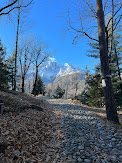
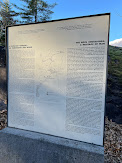
Overview
We’ve been up and down this valley half a dozen times and never had the opportunity to stop until today to see the petroglyphs. The what!? The petroglyphs or rock drawings of Valcamonica, recognized by UNESCO in 1979. It was Italy’s first recognized site.
All the rock drawings taken together represents rock carvings/art going back to the 8th-6th millennium BC. Pretty impressive.
All the rock drawings taken together represents rock carvings/art going back to the 8th-6th millennium BC. Pretty impressive.
Today, we stopped in just one of many parks in the region and spent a few hours. We are at Capo di Ponte, in the Province of Brescia, Italy. Specifically, we are just on the edge of the village and uphill in the Parco nazionale delle incisioni rupestri di Naquane.
This park was created in 1955 by the Archaeological Superintendence of Lombardy, extends over 35 hectares on hills east of the Oglio river, ranging in altitude from 400 to 600 meters above sea-level. There are many paths within the park that allow you to get up close to the engravings.
- Ample parking here: location.
- Google Street View of the site.
- The park is ordered by “rocks”. Think of each rock like a huge canvas. (Who knows what other canvases lie beneath the moss and debris?)
- Up close the “great” rock: Naquane Great Rock, Valcamonica, virtual tour entry (europreart.net)
- We spent about 1.5 hours here and didn’t see it all! (We only show a couple of the “rocks” here.) We had planned to see the nearby Rock art Natural reserve of Ceto, Cimbergo and Paspardo as well but a lunch appointment beckoned us to leave. We’ll be back!
- If you are looking for a fun lunch spot, try Osteria Concarena in the cute village of Cerveno.
- Val Camonica one of the largest valleys of the central Alps, in eastern Lombardy, Italy. We travel up and down the valley going from Bergamo to Ponte di Legno / Passo del Tonale (for all sorts of outdoor activities). It’s a slightly less efficient timewise to get to Merano. (See A Week in Merano, Italy – Hiking.) Finally, if you haven’t seen the Presena glacier covered in summer to protect it, you don’t know what sad is. (See Presena Glacier – A summer visit to the covered glacier.)
- Not only are the rock drawings inscribed in UNESCO, but the whole valley is also a UNESCO World Biosphere Reserve. This valley is happening. Many of our “local” wines come from the valley.
- Val Camonica is derived from the Latin Vallis Camunnorum, "Valley of the Camunni."
- The Camuni or Camunni were an ancient population located in Val Camonica during the Iron Age (1st millennium BC); the Latin name Camunni was attributed to them by the authors of the 1st century.
Rock 1: The Great Rock
Rock 1, the Great Rock in Parco Naquane, Val Camonica: animals and hunters (left), hunter with long spear (center), Sector I (right).



Rock 1: Deer and mystery shovel (left), labyrinth (center), Sector G (right).



Rock 1: Deer and mystery shovel (left), labyrinth (center), Sector G (right).
Rock 1 information boards and view of rock 1 and viewing boardwalk.
Views of rock 1 in Parco Naquane, Val Camonia (left), with cat (center), with mystery shovel carvings (right).
The wagon scene on rock 23 was carved with a double perspective: a depiction device commonly used in the ancient times to make all the parts of an object visible: the wagon itself is represented from above while the four radiant wheels and the two horses are seen from a lateral point of view.
Rock 23: “Four-wheeled Wagon”
Rock 23: wagon carving (left) and information board (right).
Rock 35: “The Running Priest” and “Cammunian Village”.
The so-called "running priest" is lively figure that looks like it could have been done in our times. It is a male figure wearing a head gear with back bent feathers. The figure raises one of his arms while the other rests on his hip and his legs bent in a way that may suggest a running or a dance. This figure dates to the Iron Age.
Rock 35: Communian village (left and center) and running priest (right).
Left: boardwalk around rock 35 and view south down Val Camonica (left) and information board (right).
Rock 44: Halberd-Axes
We didn’t find them, but include a photo from that rock.
Rock 44: Information board and carvings.
Rock 50: Prayers, knights, "the big warrior", inscriptions.
The shovel engravings, whose first appearance dates back to the Middle-Late Bronze Age (16th-13th centuries BC), have been object of several interpretations, Among the most interesting ones it is worth mentioning the resemblance with razors discovered among grave goods in cremation burials, which is also associated with the habit of collecting the ashes of the departed. Bronze shovels have been also found in women graves both of the Golasecca Celts and of the palaeo-Venetic regions, where they are supposed to be linked to domestic activities. Finally, we must indicate the votive function of shovel groups, interpreted as symbolic representations of votive offerings. Therefore, the shovel in Valle Camonica rock art seems to have both a male and female value, and also suggests a different use of the object according to the figurative context where it is placed.
Rock 50: Big warrior (left), prayers (center), boardwalk around rock (right).
Rock 50: Winter light on rock carvings (left), viewing platform (center), fractured surface (right).

.jpg)

.jpg)
Rock 50: warriors (left) and prayers (right).
Rock 50: information boards.
General Park photos



Entrance to the park (left and center) and history of park (right).
House on the climb to the park (left), moss and rock carving (center), view over Val Camonica from the park (right).





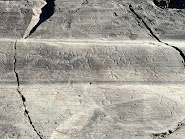

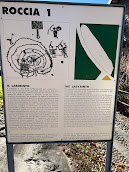


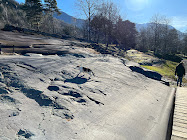
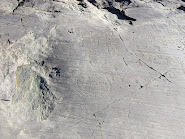
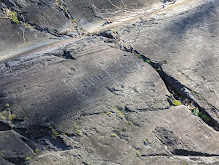
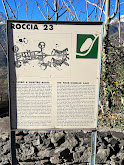


.jpg)
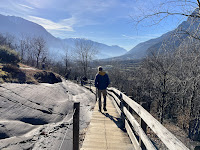



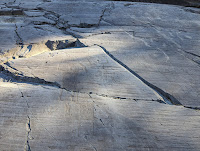




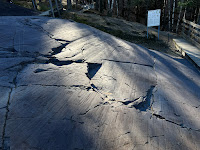


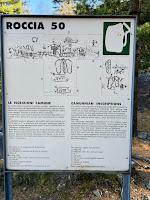
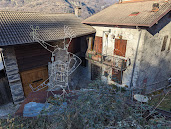


No comments:
Post a Comment
All comments are moderated. If your comment doesn't appear right away, it was likely accepted. Check back in a day if you asked a question.